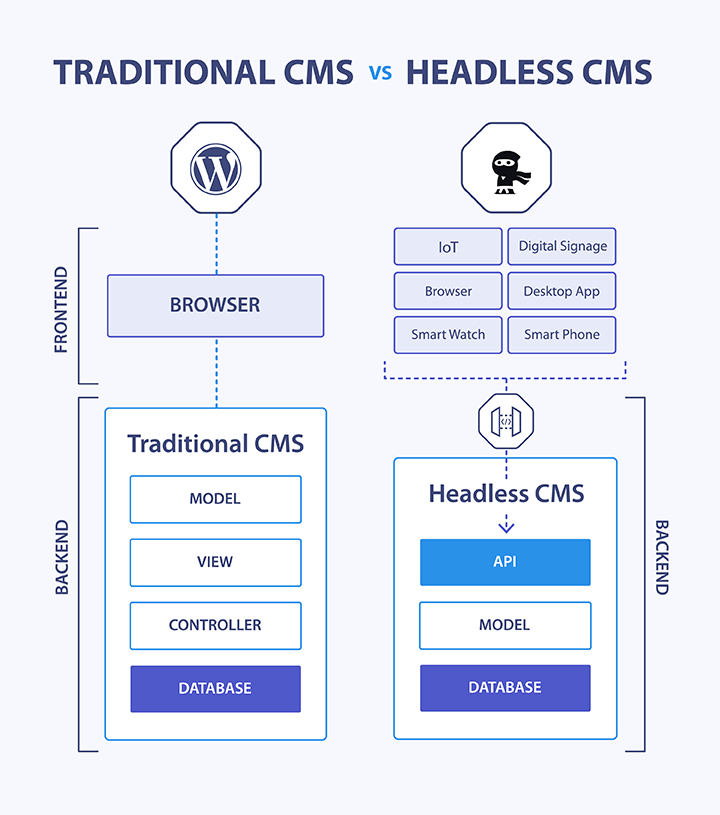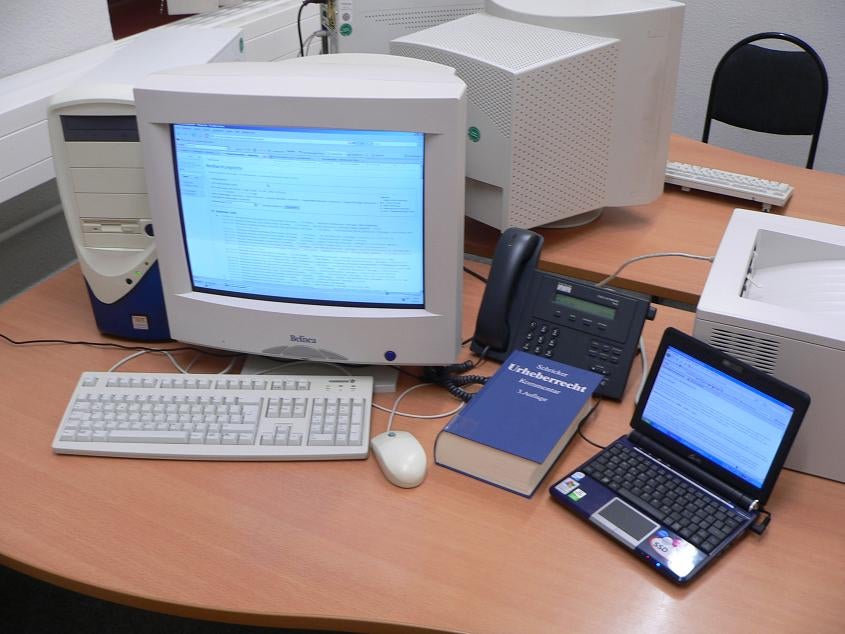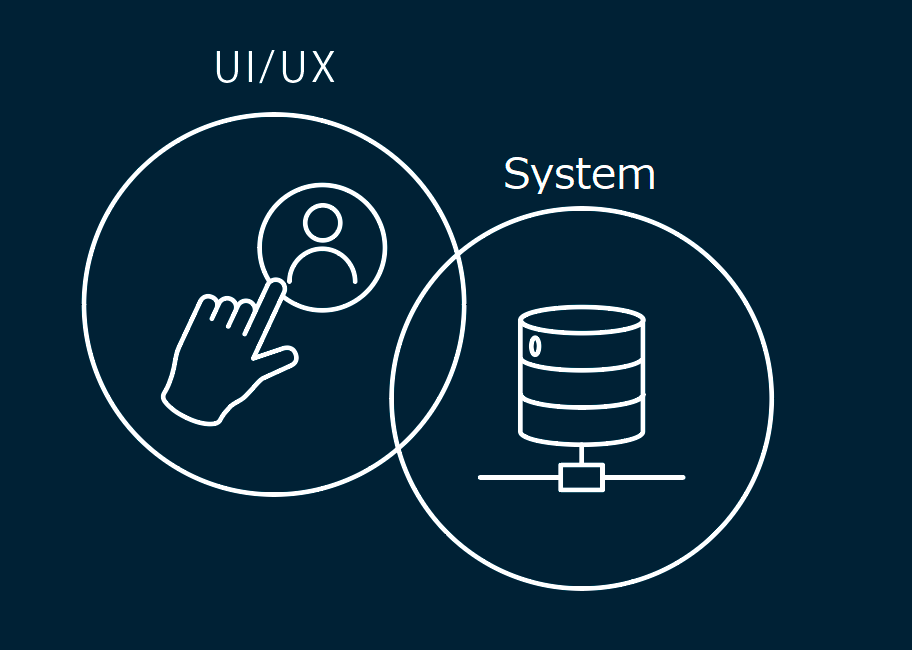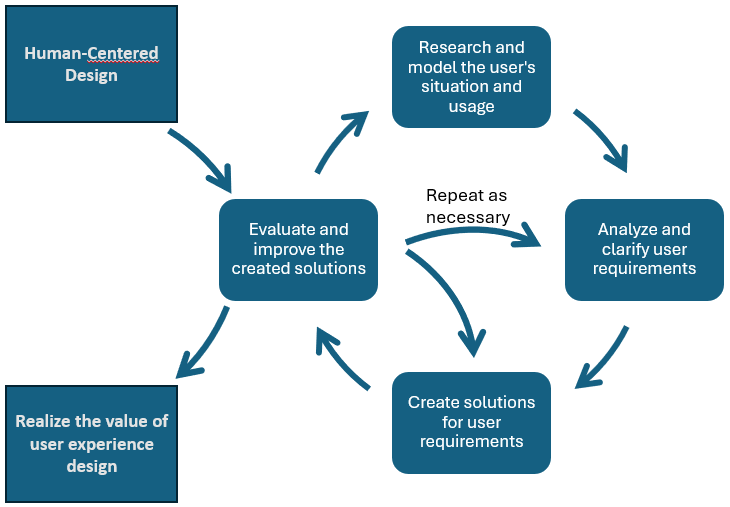What is Headless CMS? Origin, Advantages, Disadvantages, and Comparison with Traditional CMS
Kuroco is a headless CMS designed with an API-first approach. On this page, we draw on over 20 years' experience in the industry to explain the origin, advantages, and disadvantages of a headless CMS.
What is a Headless CMS
A headless CMS is an API-based CMS where the "head" (presentation layer) is separated from the back-end.
The concept began around 2016, and at that time, some headless CMS only offered APIs without a management interface. Today, most headless CMS include a management interface.

What is the Origin of "Headless"?
Why is "headless" used to refer to the lack of presentation layer?
There are various theories, but it is said that the term ‘headless’ was coined to refer to the lack of functionality of the display part of a computer, as computer manufacturers marketed display-less computers as ‘headless computers’ in the days when computer displays were as large as the one shown below. People thought of the screen as the "head" of the computer.
 Image by Marcela, available under GFDL 1.2, via Wikimedia Commons at https://commons.wikimedia.org/w/index.php?curid=5445374
Image by Marcela, available under GFDL 1.2, via Wikimedia Commons at https://commons.wikimedia.org/w/index.php?curid=5445374
The Most Well-known: Contentful
The most famous headless CMS, Contentful, was founded in 2013 and was once valued at nearly 300 billion yen. It is recognized as a next-generation web content management system.

In Japan, it started to attract attention around 2020 and rapidly gained attention around 2021. MicroCMS, a Japanese headless CMS, has also become a service attracting attention, with funding raised in September 2021.
Headless CMS operator ‘microCMS Inc.’ secures funding from Z Venture Capital.Additionally, the enterprise-oriented headless CMS "Kuroco" released its official version in April 2021.
Fully pay-as-you-go! The next-generation CMS "Kuroco" designed with an API-centric approach to transform software assets into web services within a month was officially released for DX managers.Since then, numerous Japanese headless CMS platforms have been released.
The Background of the Emergence of Headless CMS
From 2000 to 2010
From around the 2000s, blogs began to spread rapidly, with MovableType and Blogger being famous examples. It became common for companies to have websites; however, building a website could cost over 100 million yen for large companies.
However, website administrators began requesting easier ways to update their sites, similar to blogs.
This led to the trend of using the popular blogging system as an update system for corporate systems. Around that time, WordPress, an open-source and user-friendly blog system, was released.
As a result, WordPress was widely adopted as a website update system, with its plugins and other features becoming more robust, solidifying its current position.
From 2011 to 2018
The iPhone was released in 2007, and the iPhone 5 in 2013. By this time, using the internet to search for information had become commonplace. Websites needed to offer more than simple displays like slideshows; they also had to provide interactive features, user-friendly UIs, seamless switching between smartphone and PC displays, SEO, marketing, analytics, and more.
In 2010, Google announced that page speed would be a factor in search ranking algorithms, and its importance grew over time, culminating in mobile-first indexing starting in 2018.
Despite the increasing complexity of websites, the emphasis on display speed has grown.
As websites are used globally, the compatibility between traditional CMSs like WordPress and CDNs, which are crucial for display speed, was not very good.
Additionally, various devices such as smartphones and IoT devices are connecting to the internet. Smartphones often face issues with unstable connection speeds.
Amid this, JavaScript frameworks such as React, VueJS, and Angular, which are lightweight and operate with browser-side JavaScript, have emerged.
In 2010, Cloudflare was founded, followed by Fastly in 2011, Contentful in 2013, and the release of React, marking the emergence of key players in the JAMStack ecosystem.
Then, in 2014, Netlify was founded by Mathias Biilmann, who proposed the JAMStack (JavaScript/API/Markup architecture).
CMSs that provide the API (Application Programming Interface) functionalities of JAMStack are known as "headless CMS."
Additionally, the concept of SaaS (Software as a Service) by Salesforce, founded in 1999, and the cloud system offered by Amazon Web Services, starting in 2006, also became widespread.
As a result, instead of the traditional method of renting a server, installing software each time, configuring, developing, operating, and tuning, it became more convenient, cheaper, and faster to use cloud (SaaS) services.
Thus, cloud CMS became mainstream.
From 2018 to Present
As web applications became widely used, not only for information provision but also for various business applications as cloud (SaaS) systems, there arose demands for more functionalities, system integration, and customization. There were also demands for systems that could retrieve only the necessary information from JavaScript frameworks or apps.
This is where APIs come into play again. The concept of APIs has existed for over 50 years, but it was around this time that they began to be commonly available on the web.
Initially, the API part of JAMStack was designed merely as a data provider, but now it encompasses various data transactions, including payments, authentication, databases, and forms.
Kuroco, provided by Diverta, is an enterprise-oriented headless CMS with more features and greater data capacity than typical headless CMSs, making it suitable for handling large amounts of data and customization requirements. In addition to content management, Kuroco also offers a variety of APIs.
Summary of the Background, and the Future
Through various factors and evolutionary processes, the era of cloud-based headless CMS has arrived. Development methods using JAMStack, headless CMS, and JavaScript frameworks continue to evolve, making it challenging to predict how they will change over the next decade.
Headless CMS is not considered a complete replacement for traditional CMSs, which integrally manage the UI part. With the emergence of low-code web creation tools such as Wix, Squarespace, and STUDIO, it is observed that the various needs previously addressed by traditional CMSs are becoming more specialized and are being replaced by a variety of services.
The mainstream approach recently has been two-tier processing, with UI/UX handling on user devices (front-end) and content/data processing on the server side (back-end). However, with the evolution of cloud-edge technology, a third layer, the 'Edge', has been introduced, forming a three-tier structure.
Cloud-edge technology allows for the placement of small servers not directly with the user but positioned very close, enabling efficient processing. Processing tasks that were previously executed in JavaScript on the user's device, due to the distance between the user's device and the server, are now being shifted to the cloud-edge.
Various functionalities, such as databases and key-value stores, are now operating on the Edge. Vercel, the developer of Next.js, advocates for a Framework-defined infrastructure, aiming to enable frameworks to seamlessly build and connect various cloud services.
It will be exciting to see how the technology will evolve moving forward!
The coupled UI/UX and CMS slows down the speed of UI/UX improvements

Separation of UI/UX and CMS with APIs dramatically improves the speed of UI/UX improvements

Promoting Human-Centered Design (HCD) is also important for the speed of UI/UX improvements

Thus, headless CMSs are being adopted by various sites as products that meet the demands of the times. Additionally, traditional CMSs are also catching up by implementing API functionalities.
Kuroco was originally a traditional CMS, but we believed that simply adding APIs to a conventional CMS would not provide adequate value to our customers. Therefore, we carried out extensive modifications and relaunched it as an entirely new headless CMS.
What Types of Headless CMS are there?
With numerous headless CMSs being released, what are the different types available out there?
They can be broadly classified by their deployment methods, API types, features, and origins.
| Notable Product | Deployment Method | API Type | Features | Origin |
|---|---|---|---|---|
| Kuroco | Public/Private Cloud | RESTful | Content Management +API Management +Personalization and more | Converted from traditional CMS to headless CMS |
| Strapi | Open Source/Cloud Hybrid | RESTful or GraphQL | Mainly content management | Headless CMS from the start |
| Contentful microCMS | Cloud | RESTful(GraphQL) | Mainly content management | Headless CMS from the start |
| Wordpress Drupal | Open Source/Cloud Hybrid | RESTful | Content management +Personalization and more | Added API functionality to traditional CMS |
| Adobe Sitecore | Enterprise Server Installation | RESTful | Content management +Personalization and more | Added API functionality to traditional CMS |
Kuroco has been completely revamped as a headless CMS from RCMS, boasting over 4,000 clients and 15 years of history. Despite being a latecomer, it offers superior features compared to its competitors.
Traditional CMSs like WordPress and Drupal offer API-based interfaces, making them viable options for headless CMS solutions.
Additionally, commercial enterprise CMS platforms have also added APIs to accommodate headless CMS use cases.
If considering only content management, services developed as headless CMSs from the start offer the advantage of having more user-friendly interfaces. However, if you need to address requirements beyond content management, it is advisable to consider products that offer additional functionalities."
Let's now move on to a comparison of the detailed differences.
Advantages and Disadvantages of Headless CMS
Here, we will list the advantages and disadvantages of headless CMS primarily focused on content management.
Advantages of Headless CMS
Primarily, it lacks front-end functionality but offers robust API capabilities and meets recent needs as it has been developed recently.
Robust Security
Security is enhanced as external connections are limited through the API functionality.
High Performance
Many services come equipped with a standard CDN, resulting in faster API responses and can be easily configured to achieve high performance.
No Vendor Lock-in
As the front-end and back-end are connected via API, only the APIs need to be considered if the headless CMS currently in use were to be replaced during a site renewal. This does not require everything to be rebuilt at the time of renewal. Additionally, since the functionalities of the headless CMS can be used independently, it is possible to combine services and transition in stages.
Flexible Design and UI/UX
With a headless CMS, the user interface and content management are separated, making it possible to freely create the user interface on the front-end without being restricted by the CMS. Additionally, the front-end can be renewed easily.
Deployment on Various Platforms
The content of a headless CMS can be displayed on a variety of platforms via APIs. This facilitates compatibility across devices. For example, content used on a website can easily be deployed on devices such as smartphone apps and digital signage.

Simultaneous Collaboration between Developers
The separation of the front-end and back-end allows tasks to be carried out concurrently.
Disadvantages of a Headless CMS
Generally, the main disadvantage of adopting new technology is the lack of existing know-how, which necessitates skills to effectively distinguish between traditional CMSs and newer technologies. However, the knowledge required is not specific to any single CMS; it is universally applicable. Therefore, experimenting with new systems is highly recommended.
At Kuroco, we actively provide technical support to address these disadvantages. See Support for more information.

Systems are Decentralised; Understanding is Essential
First, due to the separation of the front-end and back-end, technical knowledge and a solid understanding of their interconnectivity is crucial.
Front-end Programming Required
Programming that was previously conducted on the back-end has now shifted to the front-end. Engineers familiar with traditional CMS need to adapt by learning new languages, resulting in additional learning costs.
Risk of Reinventing the Wheel
Traditional CMSs have a well-established history and offer a broad array of convenient features. In contrast, headless CMSs, which are relatively new, might lack some detailed functionalities, often necessitating the implementation of additional features on the front-end.
Kuroco, however, merges the benefits of traditional CMSs. For instance, functionalities such as pagination and navigating between previous and next pages can be seamlessly integrated through API settings.
Q: Can headless CMS be used for all types of websites?
A: No. Although headless CMS offers numerous advantages, not all website types can fully leverage these benefits. It’s crucial to conduct a thorough evaluation to select the most suitable option. As developers experienced with both traditional and headless CMSs, we are equipped to offer a balanced comparison from an informed viewpoint. For further guidance, please contact our support team.
Contact usSupport
If you have any other questions, please contact us or check out Our Slack Community.